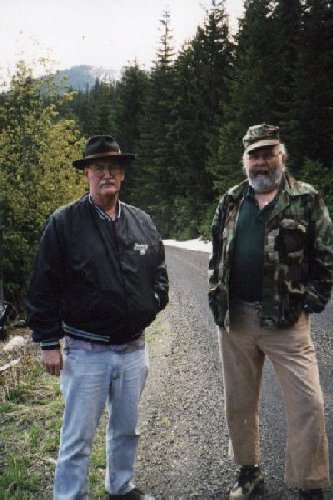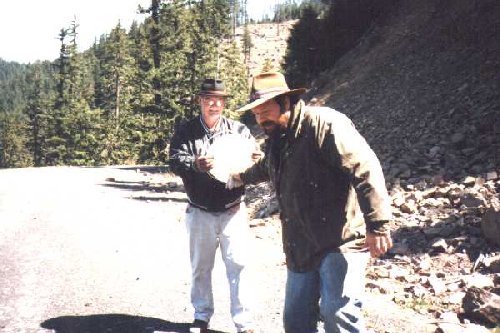 June
3, 1999 - Thursday
Ray goes up with us

Old Bigfoot hands.
Ray Crowe w/brimmed hat, Cliff Olson w/ball
cap.
Western slope of Granite Peaks 6/3/99
Roads: 224, 46, 63, 6310 (9
miles to fallen tree across road)
Beautiful late spring day. High overcast,
breaking up later into scattered clouds.
Ray Crowe drove over from Hillsboro in his
RV. His truck is still down. Trapper Steve
picked him up down at the old Thriftway
parking lot. Took Steve's truck from my place
to Cliff Olson's. Then we switched to Cliff's
Tahoe because of the seats. Very nice and
quiet rig. We could talk.
Goals for the day:
1. Show Ray some of the areas
we have searched. Ray is the Director of the
Western Bigfoot Society.
2. Consider summer sites for
I-R operated cameras.
The leaves were out much more
than the last time we were up. No easy seeing
now down off the roads.
Ray wanted to go to Indian Henry. I stayed
out of that one. Cliff and Steve wanted to go
to Granite Peaks and the Collawash River. We
considered the road up to the plateau behind
Mt. Mitchell, but decided it probably wasn't
open yet. Besides, that is a day trip just in
itself. Trapper Steve needed to be back by 5,
so we had some time constraints.
Ray wanted to stay until dark and listen.
That is the best plan and we don't do it. We
also need to get some good recording
equipment. Steve has his box and I have the
little recorder with the external mike and
that's it. Anyway, I didn't think that Ray
knew how far up and back it was. It had been
a couple of years since he had been up the
Clackamas.
We had nice talk, nothing serious. No baiting
or camera site to check, so there was no
anticipation. Not much traffic, although we
ran into vehicles at least once on all the
roads. The logging had been effectively shut
down by the environmentalists, at least for
now, so no log trucks.
   
58 - Panoramic view of
Collawash River drainage from west side of
Granite Peaks 6-3-99
Click each panel for an enlarged picture
First, went up Granite Peaks
road. At mile 9, a tree had fallen across the
road right at the mile post (Actually they
aren't posts, the vandals shoot those up,
they are plastic boards put into the ground
with a number on them. The vandals still
shoot them to pieces.) We got out and walked
about a ¼ mile plus up around the curve.
Great view of the Collawash and Hot Fork
drainages and the Dicky Peak area to the
west. We tried the bucket call. Too many
trees, no echo. Ray was impressed with our
call, I think. Cliff hadn't heard it before.
It made him laugh and laugh.

Ray Crowe and Steve Kiley with
bucket call 6-3-99
We did more with the bucket.
Cliff walked several hundred yards up the
road into some trees. He said the way Steve
pulled the cord was very interesting from in
there. He got some good echoes in the trees
too.
Forgot to mention, in the spring, the
mountain roads are covered with fallen rocks.
On our way up, there was a really big one
that had fallen off the cliffs and we barely
made it by it. We watched carefully as Cliff
drove on the hill side and he cleared it by
inches.
There were also an interesting part of spring
in the mountains up there. That was the
leavings of mouse trails under the snow. Up
near the mile 9 marker, they had worn smooth
paths on their under snow trails on the
asphalt. There were also many feet of casting
trails. Took some pictures.
There were some strange emerging plants
coming out of the little seasonal stream bed.
Tried to get some pics. but couldn't. I did
take a panorama shot with the older
auto-camera that Steve had loaned me. He
didn't really care for the quality of the
pictures that I was getting with the
disposable cameras. Didn't blame him. Anyway,
the panorama was of the Hot Fork, Dickey Peak
and Collawash River basin before us.
A jacket was all we needed today. We must
have been at least at 2500' up there. Great
day!
Ray wanted to see the Collawash, I don't
think he had ever been there, or the Indian
Henry sites, so we headed for the Collawash
due to the time factor.
On the way down, took side road downhill. No
road marker. About mile 7 ¼. Looked like an
old helicopter landing area, there for fire
use? One big, one smaller. Bare of trees and
brush and were mounded with crushed rock.
Wonder if herbicide had been put under them.
Ate lunch. Cliff came really prepared. He
brought boiled eggs, lemonade, etc.
I had an old Hershey chocolate bar in my bag
from last winter. Offered it as desert. Was a
little hard. Had been frozen several times.
Everyone politely ate their share though.
Great view, if limited. Looked up at top edge
of Granite Peaks? Not sure. To north of big
landing sit, small basin; wet, skunk cabbage.
Steve and Ray explored it. Heavy brush and
alder. Stream led up hill to a higher basin.
Good place to camp, I think.
Jumbled rock area. Bare. Covered with thick
moss. Cliff and Ray said it was like the
Thomas site. We explored it. No pits. Moss
already starting to dry out.
Near the road was an old campsite. Steve
identified it as a trapper's site from the
type of wire holding up some tripod poles and
a skinning table. I had no idea of what that
small piece of plywood was for until he told
us.
I had carefully looked over, earlier, next to
the trapper's campsite, some big rocks piled
on rotted logs. Why? Rocks very heavy and not
from right nearby. Also a large rock had been
placed on the camp's fire ring that would
take at least two men to move. The other fire
ring rocks were all man handle size. Ray
pulled one rock off the rotten trees that
weighed about 100# and it was one of the
smaller ones.
Twenty two paces from the rocks on the rotten
logs was a little natural rock shelter. There
was a line of straight stones in it. Two
large rocks that Ray said were not from the
overhang were in the entrance. I found this
first and got the others to come look.
Intentionally, we went in two separate groups
to look; Ray and me and then Cliff and Steve.
Then we compared notes.
Either an Indian fireplace, or in my opinion,
a small burial site. Some old burnt sticks
were apparent. Broke one small one in two
(pencil size). Old, blackened, no charcoal on
stick. Good wood inside. Didn't bother
anything in the heart of burial site at all.
The overhang didn't show any smoke marks. We
discussed as to whether we should report the
site to the Forest Service. Undecided.
Drove to Steve site 1 & 2. I put on 357
and loaded the hardened bullets Steve had
given me. Ray's eyes bugged out when I did
that. I went up the steep hill, while they
went to site 2 and looked over the cave below
the road.
Hill area was dry. Found 2 old imprints. One
was a step over a log like the ones we had
found before and then there was the toe and
ball marks of another step beyond it. Old.
Moss drying. Not the ones we had found
previous trips.
Heavy leaf cover. Limited visibility compared
to the winter. Worked hard and almost got to
the spur road before heading back down the
hill to the road. Very beautiful up there.
Steve reported the cabbage was still not
touched at site 2. Said it was hardening up
nicely and should be like a rock by fall.
They reported very heavy foliage along the
river bank getting to the site.
Cliff, Steve and I (at my earlier suggestion)
had been talking up hardened bullets, high
power cartridge loads, big caliber weapons
and other things like that for Ray's benefit.
He didn't seem to like the idea of us
carrying hard iron too well. He asked me:
"What I thought I'd proved?" (By
strapping on the revolver.) Just told him I
was looking around and didn't want any
surprises from blow down searching and the
like. That calmed him down and we dropped the
subject.
All day long, we talked about the Standard
Sasquatch Area theory. The others just kind
of picked up on some of my leads and took it
along to ideas I hadn't thought about.
Ray thinks there might be several species,
right in the Pacific Northwest of Sasquatch.
He bases his opinions on different concepts
than Coleman. My theory appears to supplement
his, for what he was saying.
I was continually borrowing Ray's pen and
notebook. I had left mine at home in the
truck. That wasn't too nice, but he tolerated
it. Cliff and Steve wondered what we were
talking about that took so many notes.
Between us, Ray and I were writing a lot
today.
We had a good day. I think Ray really enjoyed
it. We need a camp out.
  

All website content is © Copyright
2000, Joseph Hector Beelart, Jr. unless
otherwise noted.
All rights reserved.
Pages
created and maintained by

|